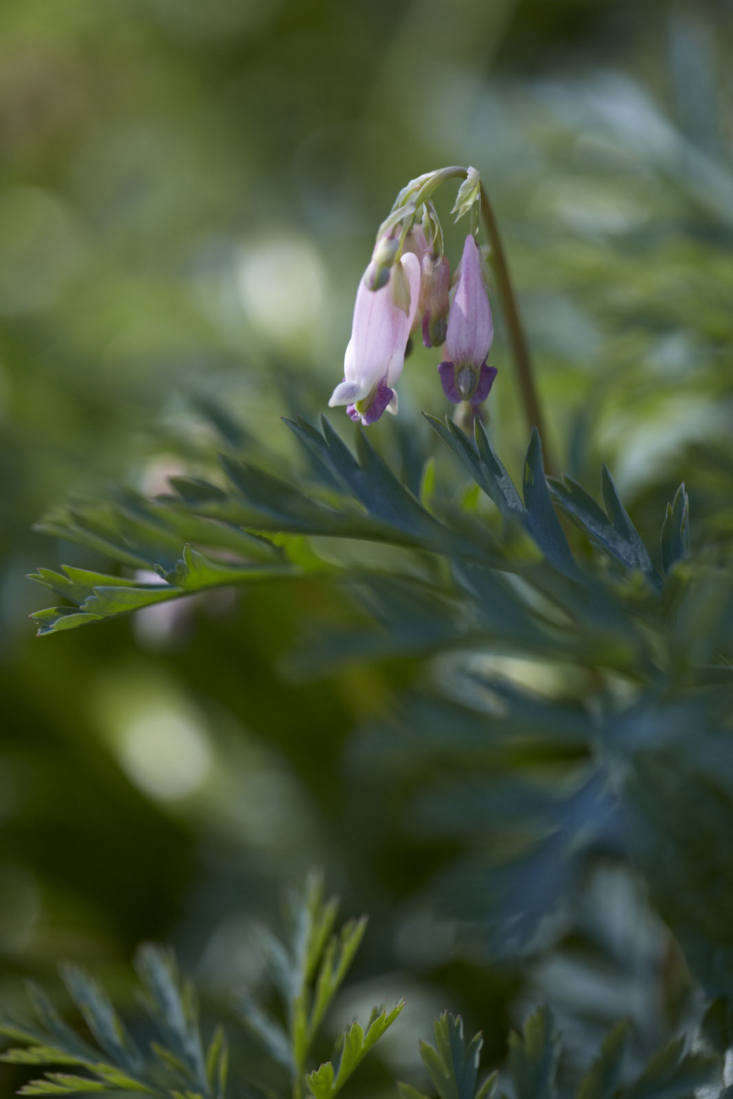Cottage gardeners were only mildly perturbed when the easygoing, arching spring beauty Dicentra spectabilis had its name changed to Lamprocapnos spectabilis. Its common name, bleeding heart, was still functional. Of course, “bleeding heart” is also used for the plants that retained the name Dicentra—the diminutive, ground-covering Dicentra formosa. Which are not to be confused with Dutchman’s breeches (Dicentra cucullaria).
Confused yet?
A quick verbal exchange about bleeding hearts seems impossible. However, simplification is at hand, bearing in mind that the plant, still considered spectacularly “Spectabilis,” is Asian, while the smaller varieties of Dicentra, of which more below, are native to America.
Photography by Britt Willoughby Dyer, for Gardenista.

One of the best aspects of all types of bleeding heart is the foliage. Dicentra is part of the poppy family, which makes the most sense if you compare its divided leaves with common poppy instead of the larger, hairier Oriental types.
The fern-like foliage of Dicentra formosa is glaucous gray-green, making a good ground cover throughout summer. Some varieties of Dicentra disappear after flowering, such as the original woodland Dutchman’s breeches (see below).

Also known as Pacific, western, or wild bleeding heart, Dicentra formosa is named in Latin for its good looks, formosa means “handsome.” It is an American western native.

The dicentra of the American northeast is Dicentra cucullaria—cucullaria meaning “hooded.” The flowers are the color of a pair of drawers but their shape makes them eminently memorable as Dutchman’s breeches, if said breeches were hanging upside down on a washing line.

The name Dutchman’s breeches is evocative enough to make anyone wonder about historical details, which are naturally poignant. A 16th-century European man of rank certainly would be dressed in wide, knee-length pantaloons, appropriating native land and flowers as he progressed through the Eastern seaboard. In The Ballads of Old New York (1920) a poem called “Dutchman’s Breeches” speaks of an exchange with Native Americans, in which an arriviste offered to buy a piece of land the size of his breeches. These turned out to be “a mighty garment” when spread out on the ground, covering an impossibly large tract of land.

Because American bleeding hearts are so much smaller than the Asian ones, they can get lost in a busy woodland garden. This is especially the case with darker flowers such as D. formosa ‘Bacchanal’ (named after Bacchus, god of wine). Too much shade and they will not be noticed, before disappearing altogether. Sunshine is fine; it’s the soil that needs to remain moist, and this can be achieved with mulching. Dicentra can also be displayed more prominently in a pot but will be happier ultimately in a blanket of leaf litter in a well-drained, sheltered place.


For more growing tips and garden design ideas, see Dutchman’s Breeches: A Field Guide and more of our favorite Ground Covers and Perennials in our curated Garden Design 101 guides. For more woodland natives, see:
- Gardening 101: Trilliums
- Wild Flower Society: 10 Outside-the-Box Native Plants
- 9 Radical Ways to Face Climate Change, with Brooklyn’s Rebecca McMackin








Have a Question or Comment About This Post?
Join the conversation